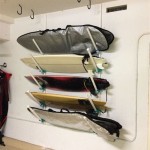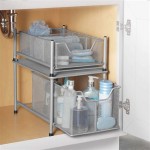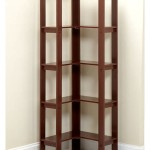Optimizing Pantry Space: Practical Storage Ideas for Enhanced Organization
The pantry, a critical component of most kitchens, often becomes a repository for groceries, small appliances, and other essential household items. The efficient organization of this space is paramount for maintaining an orderly kitchen, reducing food waste, and simplifying meal preparation. A well-organized pantry streamlines cooking processes, allows for quick inventory checks, and prevents the accumulation of expired or forgotten items. This article explores various pantry storage ideas designed to maximize space and enhance overall functionality.
Maximizing Vertical Space with Adjustable Shelving
One of the most fundamental aspects of effective pantry storage is the strategic utilization of vertical space. Standard pantry shelving is often fixed, resulting in wasted space between shelves. Replacing or supplementing these fixed shelves with adjustable shelving systems allows for customization based on the specific needs of the user. Adjustable shelves accommodate items of varying heights, eliminating unused space and facilitating better visibility of stored goods.
When implementing adjustable shelving, it is crucial to consider the load-bearing capacity of the shelves themselves. Ensure that the material used is sturdy enough to support the weight of heavier items such as canned goods or bulk containers. Common materials include solid wood, plywood, and heavy-duty wire shelving. The chosen material should also be resistant to moisture and easy to clean, as spills are common occurrences in a pantry environment.
The installation of adjustable shelving typically involves the use of shelf brackets or tracks that are mounted to the pantry walls. These brackets or tracks provide slots or notches at regular intervals, allowing for the repositioning of shelves as needed. The spacing between these intervals should be relatively small to provide maximum flexibility in shelf placement. Furthermore, it is advisable to use safety locks or other mechanisms to prevent the shelves from accidentally dislodging, especially when storing heavy items.
Beyond traditional adjustable shelves, consider pull-out shelves or roll-out trays. These options are particularly useful for accessing items stored deep within the pantry, reducing the need to reach and potentially knock over other items. Pull-out shelves are ideal for storing items such as pots, pans, or small appliances, while roll-out trays are well-suited for smaller items like spices, condiments, or snacks.
The overall design of the adjustable shelving system should also take into account the frequency with which different items are used. Items that are accessed regularly should be stored at eye level or within easy reach, while less frequently used items can be stored on higher or lower shelves. This arrangement promotes efficiency and reduces the risk of strain or injury when retrieving items.
Utilizing Door and Wall Space with Hanging Organizers
Often overlooked, the inside of the pantry door and the surrounding wall space offer valuable opportunities for storage expansion. Hanging organizers, such as over-the-door storage racks and wall-mounted baskets, can significantly increase the available storage capacity without taking up valuable shelf space. These organizers are particularly effective for storing smaller items that tend to get lost or cluttered on shelves.
Over-the-door storage racks typically consist of a series of shelves or pouches that hang from the top edge of the pantry door. These racks are ideal for storing spices, condiments, snacks, or cleaning supplies. The depth of the shelves or pouches should be carefully considered to ensure that they do not obstruct the door’s closing mechanism. Furthermore, the weight capacity of the rack should be adequate to support the intended contents.
When selecting an over-the-door storage rack, it is important to choose a model that is compatible with the thickness of the pantry door. Some racks are designed to fit standard door thicknesses, while others may require adjustments or modifications. It is also advisable to choose a rack made from durable materials that can withstand regular use and potential impacts.
Wall-mounted baskets or shelves provide another option for utilizing vertical space. These organizers can be mounted directly to the pantry wall, providing convenient storage for items such as produce, baking supplies, or cookbooks. The size and configuration of the baskets or shelves should be tailored to the specific needs of the user and the available wall space.
The installation of wall-mounted organizers requires careful consideration of the wall’s construction. Ensure that the mounting hardware is appropriate for the wall material (e.g., drywall, plaster, or wood) and that it is securely anchored to studs or other structural supports. This will prevent the organizers from pulling away from the wall under the weight of the stored items.
In addition to hanging organizers, magnetic strips can be used to store spice jars or metal utensils on the pantry door or wall. This option is particularly useful for maximizing space in small pantries where every inch counts. The magnetic strips should be strong enough to securely hold the items in place, preventing them from falling and creating a mess.
Implementing Clear Containers and Labeling Systems
Maintaining a well-organized pantry is not solely about maximizing space; it also involves ensuring that items are easily visible and accessible. The use of clear containers and a comprehensive labeling system is essential for achieving this goal. Clear containers allow for quick identification of the contents without the need to open each container, while labels provide additional information such as expiration dates or storage instructions.
When selecting clear containers, opt for those made from durable, food-safe materials such as plastic or glass. Plastic containers are typically lighter and more impact-resistant, while glass containers are non-reactive and can be used for storing a wider range of food items. The shape and size of the containers should be chosen based on the types of items being stored. For example, tall, cylindrical containers are well-suited for storing pasta or cereal, while rectangular containers are ideal for storing snacks or baking supplies.
The use of airtight containers is particularly important for preserving the freshness of food items. Airtight containers prevent moisture and air from entering, which can cause food to spoil or become stale. These containers are especially beneficial for storing items such as flour, sugar, coffee, or tea.
A well-designed labeling system should be clear, concise, and easy to read. Labels can be created using a label maker, a permanent marker, or printable labels. The labels should include the name of the item, the date it was purchased or opened, and any relevant storage instructions. Placing the labels on the front of the containers ensures that they are easily visible when the containers are stored on shelves.
Consider using color-coded labels to further enhance organization. Different colors can be assigned to different categories of items, such as baking supplies, snacks, or canned goods. This visual cue can help to quickly locate specific items and streamline the cooking process.
In addition to labeling individual containers, it is also helpful to create a master inventory list of all items stored in the pantry. This list can be kept on a clipboard inside the pantry or stored electronically on a computer or mobile device. The inventory list should be updated regularly to reflect any changes in the pantry’s contents. This list can be used to create a shopping list and prevent overbuying.
The implementation of clear containers and a labeling system is a continuous process that requires regular maintenance. Periodically check the expiration dates on stored items and discard any expired goods. Clean the containers regularly to prevent the buildup of dust or debris. By maintaining a well-organized and labeled pantry, users can reduce food waste, save time, and enhance the overall functionality of the kitchen.
By implementing these pantry storage ideas, homeowners can significantly improve the organization, accessibility, and efficiency of their kitchen space. These strategies promote a more streamlined cooking experience and contribute to a more organized and functional home environment.

Can Storage Ideas Solutions How To Organize Canned Food

15 Canned Food Storage Ideas To Organize Your Pantry

Pantry Ideas Diy Canned Food Storage Shanty 2 Chic

Pantry Storage Ideas 16 Top Canned Food S

The Best Pantry Organization Ideas From Pros Zhush

40 Genius Pantry Organization Ideas

Mum S Organising How To Cans In Your Kitchen Pantry Kidspot

18 Genius Ideas To Organize Cans In Pantry Making Maanita
:strip_icc()/neatbymeg_106172873_274590097294485_493866119012562613_n-a23994c0bfca45f1950eacf2e55991c8-1b66711570f44bab95880374e4bbde69.jpg?strip=all)
16 Pantry Organization Ideas For Tidy Shelves

25 Pantry Organization Ideas To Whip Your Space Into Shape
Related Posts








